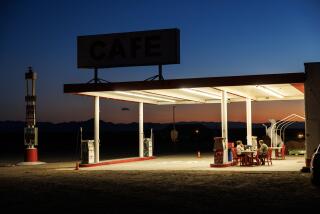A Photographic Road Trip Down Memory Lane, Paved With Melancholy
- Share via
In his introductory essay to this handsome photo study, Phil Patton states: “Like television, American highways are a national network, a mass medium. Driving, in fact, has been studied by psychologists as a process not unlike watching television. . . . [Highways] have often rolled, like some gigantic version of the machines that built them, through cities, splitting communities into ghettos, displacing people, and crushing the intimacies of old cities.”
Driving highways has become a fact of American life. While the push westward to settle the frontier was one of the seminal elements in the history of America, even after the frontier was settled, the urge to move remained.
Easterners came west, lured by promises of cheap land in growing states and cities; Westerners went east to acquire sophistication. Northerners moved south to escape freezing winters; Southerners, including many African Americans, sought freedom and economic opportunity in the North. The highways facilitated these movements.
The first recorded automobile trip across the continental United States was completed in 1903, and it took physician Nelson Jackson and his chauffeur three months to complete the journey. Sixteen years later, a special U.S. Army expedition from Washington, D.C., to San Francisco required only eight weeks, moving at an average speed of 4 mph, as part of an advertising campaign for better roads.
During the next decade and a half, major road trips became more common and less demanding. Local civic associations worked to ensure that their towns would be linked to the slowly growing highway network. In 1926, the first motel opened on a stretch of road between San Francisco and Los Angeles. About the same time, the federal government numbered all the highways and introduced the now-familiar highway symbol.
A major turning point occurred in 1940, with the completion of the first “magic motorway”--a term that had been coined the year before to describe the dioramas Norman Bel Geddes designed for General Motors’ Futurama at the New York World’s Fair. That 160-mile stretch of the Pennsylvania Turnpike, later referred to as Interstate 76, was officially opened at midnight Oct. 1. By Oct. 6, the turnpike was clogged with massive traffic jams.
Development of the National Highway System during the postwar era reflected the Cold War mentality. Highways were intended to provide both a way to move troops in case of an invasion and a means of evacuating major cities in the event of a nuclear attack.
In 1978, the last section of I-90, linking Seattle to Boston, was completed--and marked not by a golden spike but with a gold-painted section of pavement.
*
‘Highway” presents a melancholy celebration of the earlier decades of American motoring, when Route 66 and other major arteries went through many small towns. When new roads bypassed those towns, once-prosperous communities withered away.
Photographer Brouws evokes a feeling of inexorable extinction in photographs of the scabrous sign of an abandoned gas station, the peeling walls of a defunct motel room and the gritty shadows of an old factory.
Patton echoes that imagery when he states: “A rusty-red track of decay runs through the wealthiest country in the world. Where the odor of transience rises to your nose and faded colors remind you of yesteryear, there lies the fifty-first state, the realm of ruins. It is everywhere--somewhere on a California highway where a defunct diner slowly rots away, or . . . in the expanse of Wisconsin, where wind and weather whistle through thousands of deserted farms.”
All that’s missing is the sound of a honky-tonk tune on the jukebox in a roadside bar.
Unfortunately, the effect of this bittersweet book is spoiled by its needlessly fussy design. Random sentences are set in oversize type or printed in white on black, which disrupts the flow of the text: It’s like trying to drive with someone hollering in the background.
*
Highway 1 contributor Charles Solomon can be reached via e-mail at highway1@latimes.com.
More to Read
Sign up for The Wild
We’ll help you find the best places to hike, bike and run, as well as the perfect silent spots for meditation and yoga.
You may occasionally receive promotional content from the Los Angeles Times.






